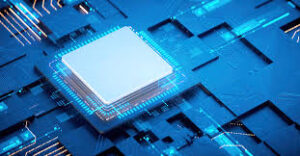Integrated Circuit IC
Integrated circuits (or ICs) are the black chips you see on just about every circuit board you encounter. They’re the heart and brains of most electronic devices, from cell phones to automobiles, and they’re a keystone of modern electronics technology, enabling us to advance in areas like artificial intelligence, virtual reality, and even autonomous vehicles.
The technology that powers ICs dates back to 1947, when William Shockley and his team discovered that certain crystals could manipulate electrons, allowing them to perform electrical functions that were previously impossible with vacuum tubes. The first transistors were invented to take advantage of this discovery, and they were a crucial building block for digital electronics, such as logic gates and computers. They also enabled analog electronics such as audio or signal amplification.

But working with so many separate transistors was impractical, and this is when the idea of integrating them into one chip was born. In 1958, Jack Kilby of Texas Instruments, Inc. and Robert Noyce of Fairchild Semiconductor Corporation independently thought up ways to reduce component size by laying thin paths of metal directly on top of the devices themselves, which functioned as wires. This allowed them to pack hundreds of transistors onto a piece of material the size of a pea, and this was the birth of the modern IC.
What is an Integrated Circuit IC?
Integrated Circuits are incredibly versatile, capable of taking the form of everything from simple radio transmitters to complex microcontrollers and amplifiers. They are also much smaller than their discrete predecessors, and fewer of them are needed to do the same job. This greatly reduces the cost and complexity of creating an electronic device, making it more affordable for consumers.
An IC consists of tiny versions of various types of components, including transistors and resistors. The overall functionality of an IC depends on how those components are configured inside it, and each comes with a datasheet that describes its components and tells you how to use them in your circuit design.
Depending on how they’re constructed, an IC can be divided into two categories: monolithic and hybrid. A monolithic IC is made of a single piece of silicon with the components all embedded in it, while a hybrid IC is composed of multiple pieces of silicon with the components mounted on different layers of the wafer. A hybrid IC is also often known as a Multi-Chip Module or MCM, and it can be either thick film or thin film.
Because ICs are so delicate, they’re packaged in a protective casing called an IC package, or “black chip.” This is what you see on the end of most ICs, and it allows us to connect them to our printed circuit boards. The IC package can vary in size, but it almost always includes leads or bumps that match the connections on the underlying chip.
Jinftry (JING FU CAI (HONGKONG) INTERNATIONAL CO., LIMITED) is a global professional one-stop procurement and service provider of electronic components. It uses independent distribution, platform distribution combined with the Internet online sales model to sell various products worldwide. Types of electronic components, providing one-stop component procurement and supply chain services to global OEM factory customers and brokers. Sales include integrated circuits, discrete semiconductors, IGBT modules, connectors, capacitors, diodes, transistors and other electronic components, covering power supply, automotive, communications, computers, consumer products, medical, industrial, mobile phone and other application fields.
Jinftry product line cards: TI, ONSEMI, Microchip, Maxim, NXP, STM, Xilinx, Intel, Infineon, Broadcom, Renesas, samtec, Souriau, CISSOID, Mitsubishi, FUJI, Semikron, etc.

Website: https://www.jinftry.com
Shenzhen Operation Center Address: 26F1, Building C, Electronic Technology Building, Shennan Middle Road, Futian District, Shenzhen, Guangdong, China
Hong Kong company name: JING FU CAI (HONGKONG) INTERNATIONAL CO., LIMITED
Registered address of Hong Kong company: Unit No.A222,3F,Hang Fung Industrial Building,Phase2,No.2G Hok Yuen Street,Hunghom,Kowloon,Hong Kong
Email: [email protected]
Tel: +86-755-82518276